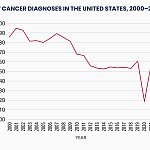
According to the
Now, a study led by Canadian scientists has found that a structured exercise program following surgery and chemotherapy for colon cancer reduced patients’ chance of cancer recurring by 28% compared with patients given only health advice.
The study, which is published in The New England Journal of Medicine (NEJM), also found that structured exercise reduced the risk of death from any cause by 37%.
Experts have said these results suggest exercise could be ‘better than a drug’ at preventing colon cancer recurrence.
Speaking to the Science Media Centre, David Sebag-Montefiore, MB BS, MRCP, FRCP, the Audrey and Stanley Burton Professor of Clinical Oncology and Health Research, University of Leeds, United Kingdom, who was not involved in the trial, commented that:
“This is excellent news for future patients with bowel cancer and is likely to bring additional health benefits […[ The great appeal of a structured moderate intensity exercise is that is offers the benefits without the downside of the well-known side effects of our other treatments.”
The researchers recruited 889 people mostly in Canada and Australia, but with some from the United States, the U.K., and France for this study, which formed part of the Colon Health and Lifelong Exercise Change (CHALLENGE) trial.
All those enrolled in the trial, between 2009 and 2024, had undergone surgery for stage 3 or high-risk stage 2 colon cancer, followed by adjuvant chemotherapy to help prevent the cancer returning. They ranged in age from 19 to 84 years, with a median age of 61.
Most participants had a
Researchers randomly assigned all participants to one of two groups.
The exercise group — made up of 445 patients — worked with a certified physical activity consultant for 3 years. For the first 6 months the consultants saw them every week, then fortnightly for the second 6 months, and monthly for next 2 years.
These participants could choose the type, frequency and intensity of aerobic exercise, but the aim was to achieve the equivalent of 3-4 brisk 45-60 minute walks a week.
The health-education group (444 patients) received general health-education materials promoting physical activity and healthy nutrition in addition to standard surveillance.
At a median follow-up of 7.9 years, 93 people in the exercise group and 131 in the health-education group had experienced a recurrence of their cancer, a new primary cancer, or had died. In total, 107 died from any cause — 41 in the exercise group, 66 in the health-education group.
People in the exercise group did not lose weight, but saw a general improvement in physical functioning and significantly longer disease-free survival, with an annual incidence of recurrence, new primary cancer, or death of 3.7%, compared with 5.4% in the health-education group.
In the exercise group, 80.3% of patients were disease-free after 5 years, compared with 73.9% of the health-education group.
Lead author on the study, Kerry S. Courneya, PhD, Professor and Canada Research Chair in Physical Activity and Cancer at the University of Alberta in Edmonton, Canada, told Medical News Today that the most important finding of their study was the overall improvement in survival.
Julie Gralow, MD, Chief Medical Officer of the American Society of Clinical Oncology (ASCO), who was not involved in the trial, said the findings suggest that exercise could be “better than a drug” for cancer patient outcomes, because it does not have the related side effects.
However, she cautioned: “I did not mean to suggest that we omit drugs in favor of exercise, my intention was to compare the magnitude of benefit we get from standard therapies to what exercise achieved in terms of reduction of recurrences and deaths, also taking toxicity into account.”
She added that while there were effective drugs that help prevent recurrence in patients with particular mutations for colon cancer, “exercise’s benefit in colon cancer patients is not restricted to these specific mutations.”
Courneya emphasized the benefits of their program:
“The ‘side effects’ of exercise are almost all good (fitter, stronger, less fatigue, less depression, lower [cardiovascular disease] risk, etc.). I think exercise keeps having an effect on new primary cancers and possibly other causes of death. Intervention participants were still doing more exercise than health education at years 4 and 5.”
A supervised exercise program can also be much cheaper than medication.
“The [physical activity] intervention was maybe 3,000 to 5,000 [Canadian dollars] whereas it is not uncommon for some cancer drugs to be 10s of thousands and even reach 100,000,” Courneya added.
Vicky Coyle, U.K. lead researcher for the trial and Clinical Professor at Queen’s University Belfast, Northern Ireland, told MNT that:
“Our study gives clear, encouraging evidence that physical activity can reduce the risk of cancer returning for some people with colon cancer. We now need to work with policymakers and healthcare providers to embed exercise into treatment plans where appropriate.”
Joe Henson, PhD, Associate Professor in Lifestyle Medicine at the University of Leicester, who led exercise sessions in Leicester, U.K. for the trial, highlighted the need for support.
“Despite its proven benefits, many people still face barriers to engaging in regular exercise. This study shows how important it is to make exercise advice a routine part of cancer care and to offer people tailored support,” Henson told us.
Although she emphasizes the importance of exercise to her own patients, Gralow noted that implementing exercise programs like those in this study could be difficult:
“I question whether most clinics have enough personnel to accommodate this number of visits (especially since prior observational data suggests many other cancer types — including common ones like breast and prostate cancer — benefit from exercise). I also question whether all or even most patients are willing to come in this often.”
“So,“ she said, “we need to find alternative ways to support our patients in incorporating exercise into their lives that do not require clinic visits but do provide regular support and encouragement. And we need to make sure we, the clinicians, are recommending this (a prescription for exercise!).”





